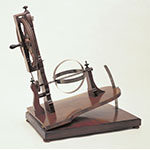This instrument, like the apparatus inv. 1027, is used to perform experiments on the centrifugal force. The wooden base carries a hinged board whose slope can be adjusted by a metal arc and a fastening screw. The board supports a vertical frame carrying a wheel fitted with a handle. The handle, via a lathe and pulley, rotates a horizontal iron axle bearing two perpendicularly placed elastic metal blades that form two meridians of a sphere. When the axle is spun, the centrifugal force distorts the blades, turning the sphere into a rotating ellipsoid whose flatness increases in proportion to the velocity. There is a mechanism for blocking the blades at the point of maximum flattening. The apparatus thus offers a convincing demonstration of the cause of the Earth's flattening at the poles, which is precisely the vortical rotation of our planet on its axis. The instrument also came with a glass globe (missing) to replace the axle with blades. The globe was filled with a mixture of water and a liquid of different density, or with water containing a wax pellet or an air bubble. With such combinations, the globe provided a demonstration of the effects of gravity combined with the centrifugal force. The operating principle of the apparatus was described by Jean-Antoine Nollet in Leçons de physique expérimentale (Paris, 1743-1748). Provenance: Lorraine collections.









